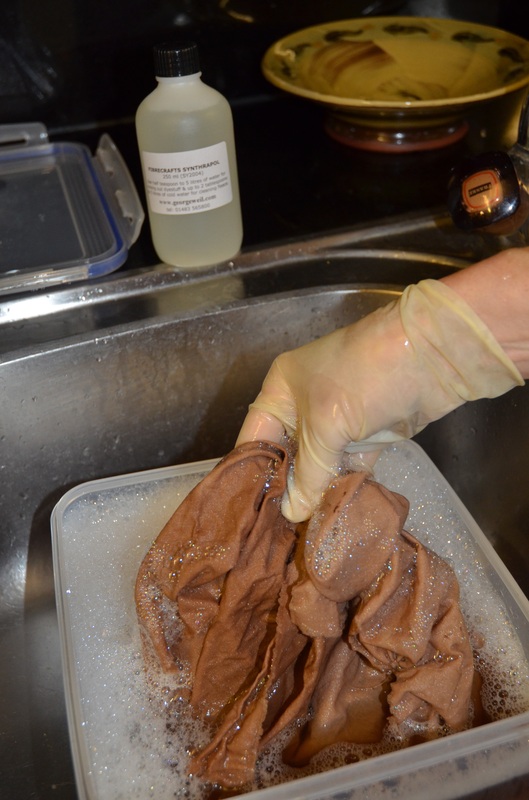|
The results from my natural dyeing experiments are featured in today's post. I was a bit disappointed that the Japanese Maple leaves did not dye the fabric red, as the dye liquid was really quite a deep shade of scarlet. But I'm pleased anyway as the fabric has such a wonderful natural colour that would have been impossible to achieve with other types of dyes. The photo above shows the fabric dyed with salt on the left and without salt on the right - quite a difference! The salt gives a deeper colour to this and to the fabric dyed with Eucalyptus bark which is featured below. Again, salt was added to fabric on the left, no salt on the right. Remember, both of these were mordanted with alum acetate. You might say these two sets of fabrics look very similar to one another and you wouldn't be wrong, but I do like the subtle differences and can't wait to use them! I also dyed some fabric with turmeric. The results are above - a really lovely shade of yellow. This picture doesn't do it justice.
So I'd say I had a successful time with my natural dyeing and will certainly do it again in the future. But the book beckons and I'm on to applying colour to fabric through painting and monoprinting. I'll post some of my results soon.
4 Comments
While I was photographing Jack, I decided that those Japanese maple leaves would be one of my first natural dyestuffs, so I collected a very large amount in a stainless steel pot. I covered the leaves with water and soaked them for about an hour. I then simmered the leaves for about 5 hours (covered) and left everything to cool overnight. The next day I strained out the leaves, (put them on the compost heap) and poured the reddish-brown broth into a plastic container. For another dyestuff, I gathered Eucalyptus bark that had dropped on the ground all around a tree in my garden (never remove bark from a living tree, it goes without saying). I soaked the bark in warm water overnight (some natural dyers soak bark for much longer but I was too impatient), then boiled it for about 8 hours the next day—a lovely aroma permeated the house. I let the bark soak in the water for a couple of days, then poured that dark brown solution into a separate plastic container. In the meantime, while the leaves and bark were cooking and soaking, I scoured several fat quarters of my 100% cotton fabric in a hot machine wash to prepare them for dyeing, and soaked them in Synthrapol for a few minutes before rinsing them in warm water. I then added a mordant to the fabrics by simmering them in an alum acetate solution for an hour, then leaving them in the solution overnight. A mordant is a chemical agent that adheres to both fibers and dye, binding them together; the term is derived from the Latin mordere, which means “to bite”. The next day I divided the Japanese maple leaf broth into 2 stainless steel pots (never again to be used for cooking!). I added a tablespoon of salt to one pot, and then immersed one fat quarter of the mordanted fabric into each pot. I simmered the fabrics for one hour, not letting the solutions come to a boil. I removed the fabrics from the pots, rinsed them under running water and soaked them in Synthrapol. I repeated this process with the Eucalyptus solution. Next time I'll show you the dyed fabrics and how they were affected by the salt.
|
Archives
March 2023
Categories
All
|







 RSS Feed
RSS Feed